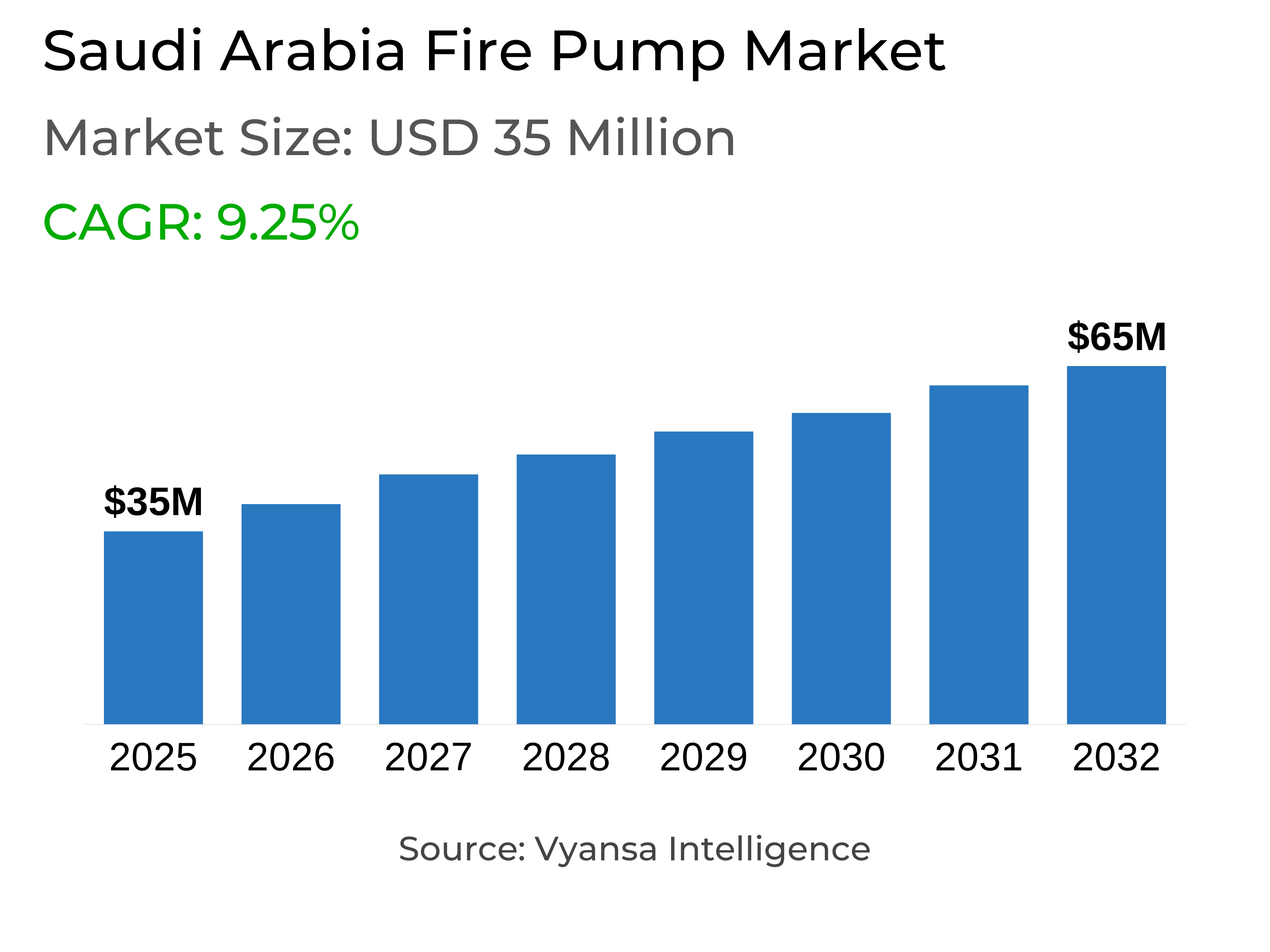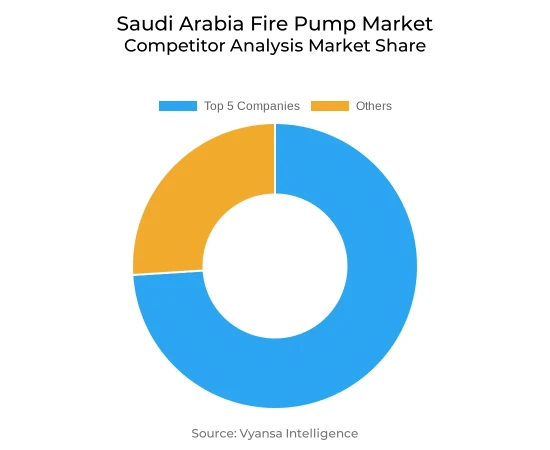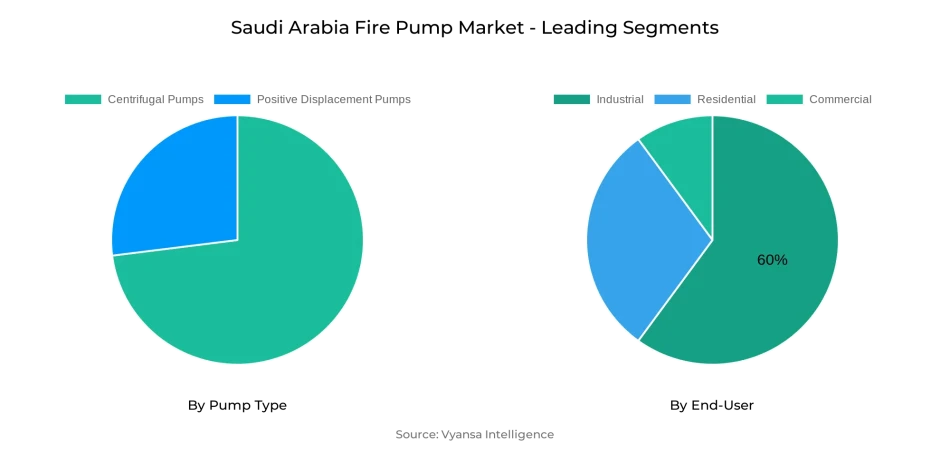
Saudi Arabia Fire Pump Market Report: Trends, Growth and Forecast (2026-2032)
By Pump Type (Centrifugal Pumps (Overhung Pumps, Vertical Inline, Horizontal End Suction), Split Case Pumps (Single/Two Stage, Multi Stage)), Positive Displacement Pumps (Diaphragm Pumps, Piston Pumps), By Mode of Operation (Diesel Fire Pump, Electric Fire Pump, Others), By End-User (Residential, Commercial, Industrial)
- Energy & Power
- Oct 2025
- VI0507
- 120
-




Saudi Arabia Fire Pump Market Statistics and Insights, 2026
- Market Size Statistics
- Fire Pump in Saudi Arabia is estimated at $ 35 Million.
- The market size is expected to grow to $ 65 Million by 2032.
- Market to register a CAGR of around 9.25% during 2026-32.
- Pump Type Segment
- Centrifugal Pumps continues to dominate the market.
- Competition
- More than 10 companies are actively engaged in producing Fire Pump in Saudi Arabia.
- Top 5 companies acquired the maximum share of the market.
- WILO SE, Ebara Corporation, ITT Goulds Pumps, Flowserve Corporation, Pentair PLC etc., are few of the top companies.
- End-User
- Industrial grabbed 60% of the market.
Saudi Arabia Fire Pump Market Outlook
The Saudi Arabia Fire Pump Market is also seeing robust traction with Vision 2030's extensive infrastructure development and government investment. The size of the market was $35 million in 2025 and is anticipated to be $65 million in 2032 at a CAGR of approximately 9.25% from 2026–32. Growing construction activity, giga projects like NEOM, The Red Sea Project, and Qiddiya, and increasing investments in water, sewerage, and transport infrastructure are fueling high demand for fire protection systems, where fire pumps are a key component.
In spite of the growth, the market is plagued with structural issues, especially workforce availability and compliance complexity. The industry needs more than 90,000 qualified personnel, but it still depends a great deal on expatriates, thus causing delays in execution. Besides, compliance with rigorous regulatory provisions under the Saudi Building Code (SBC 801) and global standards such as NFPA and ISO tends to add project duration and cost. Such issues point towards enhancing training and simplifying the process of approvals in order to keep up with the speedy rate of current construction processes.
Technological change is also transforming the market. Convergence of AI, IoT, and predictive safety systems is facilitating real-time monitoring, early warning, and improved responsiveness in both urban and industrial environments. Initiatives such as NEOM are leading the development of advanced smart city fire safety systems, supporting the use of contemporary fire pumps conducive to digitally enabled infrastructure. These changes guarantee enhanced operational efficiency and better fire risk management throughout the Kingdom's fast-changing built environment.
By segment, centrifugal pumps lead the market with their established reliability, efficiency in terms of costs, and adherence to local and international standards. By end-user, the industrial sector has the biggest share at 60% and is growing the fastest, driven by Saudi Arabia's diversification of its economy into petrochemicals, manufacturing, and logistics. This nexus of mega infrastructure developments, regulatory foundations, and industrial growth places fire pumps as a critical element of Saudi Arabia's development programme up to 2032.

Saudi Arabia Fire Pump Market Growth Driver
Expanding Infrastructure Spurs Fire Safety Requirements
Saudi Arabia's Vision 2030 development program is driving phenomenal demand for sophisticated fire safety solutions, including fire pump systems. The government is setting aside SAR1.3 trillion ($342.7 billion) in its budget for 2025, allocating a significant portion to construction and infrastructure. Among the key projects are 15 sewage infrastructure projects totaling SAR2.3 billion ($613.3 million) and 30 water and sewerage projects in Riyadh worth $533 million, covering almost 2,000 km of reach. Each of these innovations requires full fire protection systems to comply and be operational.
The building industry is also complemented by strong growth, with 4% real-time growth in 2025 and projected 5.4% annual average growth from 2026 to 2029. Mega projects including NEOM's $500 billion future city, The Red Sea Project's luxury resort developments, and Qiddiya's entertainment district all total more than $1.3 trillion in value. These projects set strict fire safety compliance standards, prompting widespread adoption of smart fire pump systems on a large scale for residential, commercial, and industrial developments.
Saudi Arabia Fire Pump Market Challenge
Workforce Gaps and Regulatory Hurdles Limit Market Expansion
The fast pace of Saudi Arabian construction activity reflects urgently needed workforce shortages that both directly impede fire pump installation and maintenance capabilities. The industry has a demand for over 90,000 qualified workers, although just 12.5% of the employees are Saudi nationals and 87.5% are non-local workers. This mismatch highlights ongoing skills mismatches, since nationals' unemployment remained at 15.4% in 2020 even though there were 6.7 million private sector expatriates employed. These structural issues cause delays in implementation and challenges in ensuring fire safety system compliance.
Concurrently, the regulatory environment offers a supplementary level of complexity. Saudi Building Code (SBC 801) specifies comprehensive fire protection requirements, with high-rise and industrial constructions requiring compliance with NFPA and ISO codes also. Coordination among Saudi Civil Defense, SASO, and the municipalities tends to result in exhaustive approval procedures and increased costs of compliance. All these complex processes tend to stretch out project timelines, which further presents challenges for contractors and suppliers who need timely installation of fire pump systems.
Saudi Arabia Fire Pump Market Trend
Smart Safety Solutions Redefine Fire Protection Landscape
Digital transformation is revolutionizing the Saudi Arabia Fire Pump Market, where artificial intelligence, IoT, and predictive technologies are becoming an essential part of contemporary fire safety plans. AI-driven vision systems can recognize smoke and fire earlier than conventional alarms, and predictive modeling combines historical and environmental factors to predict possible incidents. Integration into Smart Cities models enables fire protection systems to operate within larger digital frameworks, providing real-time monitoring, responsiveness, and responsibility.
NEOM's Tonomus system is a quintessential example of future-proof safety solutions, connecting vast sensor webs to dynamically simulate urban hazards. Industrial plants and data centers are adopting IoT-based alarms, cloud monitoring, and eco-friendly suppression technologies. Multi-sensor detection solutions integrating smoke, heat, and air sampling capabilities improve early detection with minimal false alarms. These technologies add strength to operational effectiveness, allowing facility owners to monitor system status remotely and implement instantaneous action against possible threats.
Saudi Arabia Fire Pump Market Opportunity
Giga Projects Create Exceptional Growth Prospects
Saudi Arabia's giga projects offer unprecedented prospects for fire pump suppliers, contractors, and integrators. NEOM's $500 billion linear city concept demands state-of-the-art fire protection solutions tailored to sophisticated underground transit systems and high-density urban configurations. Equally, The Red Sea Project's first phase, with 16 high-end resorts and a global airport, requires state-of-the-art marine-focused fire safety infrastructure for delicate coastal ecosystems. Projects of this scale further enhance the strategic significance of trusty fire pump systems in the national construction sector.
Qiddiya, planned to be 2.5 times Walt Disney World in size, extends demand across theme parks, cultural centers, and sports arenas. The 25 functional areas of the project call for comprehensive fire protection coverage in a wide range of built environments. Government financing of SAR300 billion (approximately $80 billion) for transport, utilities, and public services further enhances long-term prospects. At the same time, economic diversification measures drive the industrial base, including petrochemicals and manufacturing, with increasing needs for heavy-duty fire extinguishing systems in high-hazard facilities.
Saudi Arabia Fire Pump Market Segmentation Analysis

By Pump Type
- Centrifugal Pumps
- Positive Displacement Pumps
Centrifugal pumps remain the leaders in the Saudi Arabia Fire Pump Market, with the largest market share under the pump type category. Their dominance is based on established reliability, reliable flow output, and general applicability across commercial, residential, and industrial environments. Centrifugal pumps are also compatible with national fire safety standards and global NFPA standards, thus making them compatible both locally and globally. Lower maintenance needs and cost efficiency further reinforce their status as the preferred choice among developers and facility managers.
Vision 2030 construction boom further pushes the demand for centrifugal pumps due to their capacity to deliver reliable water supply systems throughout mega projects. From residential high-rise buildings to industrial facilities, these pumps are a standard for Saudi Arabia's fast-growing infrastructure network fire safety compliance. Their proven track record and flexibility place them at the center of attaining short-term and long-term fire protection objectives across various development projects.
By End-User
- Residential
- Commercial
- Industrial
The industrial segment has the largest end-user proportion in the Saudi Arabia Fire Pump Market, with 60% of demand. Industrial complexes are also the fastest-growing segment, growing at a CAGR of 9.73% as the Kingdom intensifies its economic diversification through Vision 2030. Fire pump uptake in this segment is necessitated by the hazardous nature of petrochemical plants, manufacturing plants, warehouses, and logistics facilities, where highly combustible materials and intricate machinery increase fire risks.
The investments in non-oil sectors further establish the viability of the segment. With manufacturing capacity increasing and multinational companies investing in Saudi Arabia, the need for high-quality, technologically superior fire suppression systems increases proportionately. The 60% share gives an indication of the significant role played by fire pumps in the protection of industrial processes, with the double-digit growth trend reinforcing the segment's role as a major driver of market growth over the next few years.
Top Companies in Saudi Arabia Fire Pump Market
The top companies operating in the market include WILO SE, Ebara Corporation, ITT Goulds Pumps, Flowserve Corporation, Pentair PLC, Sulzer Limited, Grundfos Holding A/S, KSB SE & Co. KGaA, Patterson (Gorman Rupp), Armstrong, etc., are the top players operating in the Saudi Arabia Fire Pump Market.
Frequently Asked Questions
Related Report
1. Market Segmentation
1.1. Research Scope
1.2. Research Methodology
1.3. Definitions and Assumptions
2. Executive Summary
3. Saudi Arabia Fire Pump Market Policies, Regulations, and Standards
4. Saudi Arabia Fire Pump Market Dynamics
4.1. Growth Factors
4.2. Challenges
4.3. Trends
4.4. Opportunities
5. Saudi Arabia Fire Pump Market Statistics, 2022-2032F
5.1. Market Size & Growth Outlook
5.1.1.By Revenues in US$ Million
5.2. Market Segmentation & Growth Outlook
5.2.1.By Pump Type
5.2.1.1. Centrifugal Pumps- Market Insights and Forecast 2022-2032, USD Million
5.2.1.1.1.1. Overhung Pumps- Market Insights and Forecast 2022-2032, USD Million
5.2.1.1.1.2. Vertical Inline- Market Insights and Forecast 2022-2032, USD Million
5.2.1.1.1.3. Horizontal End Suction- Market Insights and Forecast 2022-2032, USD Million
5.2.1.1.2. Split Case Pumps- Market Insights and Forecast 2022-2032, USD Million
5.2.1.1.2.1. Single/Two Stage- Market Insights and Forecast 2022-2032, USD Million
5.2.1.1.2.2. Multi Stage- Market Insights and Forecast 2022-2032, USD Million
5.2.1.2. Positive Displacement Pumps- Market Insights and Forecast 2022-2032, USD Million
5.2.1.2.1. Diaphragm Pumps- Market Insights and Forecast 2022-2032, USD Million
5.2.1.2.2. Piston Pumps - Market Insights and Forecast 2022-2032, USD Million
5.2.2.By Mode of Operation
5.2.2.1. Diesel Fire Pump- Market Insights and Forecast 2022-2032, USD Million
5.2.2.2. Electric Fire Pump- Market Insights and Forecast 2022-2032, USD Million
5.2.2.3. Others- Market Insights and Forecast 2022-2032, USD Million
5.2.3.By End-User
5.2.3.1. Residential- Market Insights and Forecast 2022-2032, USD Million
5.2.3.2. Commercial- Market Insights and Forecast 2022-2032, USD Million
5.2.3.3. Industrial- Market Insights and Forecast 2022-2032, USD Million
5.2.4.By Competitors
5.2.4.1. Competition Characteristics
5.2.4.2. Market Share & Analysis
6. Saudi Arabia Centrifugal Fire Pump Market Statistics, 2020-2030F
6.1. Market Size & Growth Outlook
6.1.1.By Revenues in US$ Million
6.2. Market Segmentation & Growth Outlook
6.2.1.By Pump Type- Market Insights and Forecast 2022-2032, USD Million
6.2.2.By Mode of Operation- Market Insights and Forecast 2022-2032, USD Million
6.2.3.By End-User- Market Insights and Forecast 2022-2032, USD Million
7. Saudi Arabia Positive Displacement Fire Pump Market Statistics, 2020-2030F
7.1. Market Size & Growth Outlook
7.1.1.By Revenues in US$ Million
7.2. Market Segmentation & Growth Outlook
7.2.1.By Pump Type- Market Insights and Forecast 2022-2032, USD Million
7.2.2.By Mode of Operation- Market Insights and Forecast 2022-2032, USD Million
7.2.3.By End-User- Market Insights and Forecast 2022-2032, USD Million
8. Competitive Outlook
8.1. Company Profiles
8.1.1.Flowserve Corporation
8.1.1.1. Business Description
8.1.1.2. Product Portfolio
8.1.1.3. Collaborations & Alliances
8.1.1.4. Recent Developments
8.1.1.5. Financial Details
8.1.1.6. Others
8.1.2.Pentair PLC
8.1.2.1. Business Description
8.1.2.2. Product Portfolio
8.1.2.3. Collaborations & Alliances
8.1.2.4. Recent Developments
8.1.2.5. Financial Details
8.1.2.6. Others
8.1.3.Sulzer Limited
8.1.3.1. Business Description
8.1.3.2. Product Portfolio
8.1.3.3. Collaborations & Alliances
8.1.3.4. Recent Developments
8.1.3.5. Financial Details
8.1.3.6. Others
8.1.4.Grundfos Holding A/S
8.1.4.1. Business Description
8.1.4.2. Product Portfolio
8.1.4.3. Collaborations & Alliances
8.1.4.4. Recent Developments
8.1.4.5. Financial Details
8.1.4.6. Others
8.1.5.KSB SE & Co. KGaA
8.1.5.1. Business Description
8.1.5.2. Product Portfolio
8.1.5.3. Collaborations & Alliances
8.1.5.4. Recent Developments
8.1.5.5. Financial Details
8.1.5.6. Others
8.1.6.WILO SE
8.1.6.1. Business Description
8.1.6.2. Product Portfolio
8.1.6.3. Collaborations & Alliances
8.1.6.4. Recent Developments
8.1.6.5. Financial Details
8.1.6.6. Others
8.1.7.Ebara Corporation
8.1.7.1. Business Description
8.1.7.2. Product Portfolio
8.1.7.3. Collaborations & Alliances
8.1.7.4. Recent Developments
8.1.7.5. Financial Details
8.1.7.6. Others
8.1.8.ITT Goulds Pumps
8.1.8.1. Business Description
8.1.8.2. Product Portfolio
8.1.8.3. Collaborations & Alliances
8.1.8.4. Recent Developments
8.1.8.5. Financial Details
8.1.8.6. Others
8.1.9.Patterson (Gorman Rupp)
8.1.9.1. Business Description
8.1.9.2. Product Portfolio
8.1.9.3. Collaborations & Alliances
8.1.9.4. Recent Developments
8.1.9.5. Financial Details
8.1.9.6. Others
8.1.10. Armstrong
8.1.10.1. Business Description
8.1.10.2. Product Portfolio
8.1.10.3. Collaborations & Alliances
8.1.10.4. Recent Developments
8.1.10.5. Financial Details
8.1.10.6. Others
9. Disclaimer
| Segment | Sub-Segment |
|---|---|
| By Pump Type |
|
| By Mode of Operation |
|
| By End-User |
|
Research Methodology
This study followed a structured approach comprising four key phases to assess the size and scope of the electro-oxidation market. The process began with thorough secondary research to collect data on the target market, related markets, and broader industry context. These findings, along with preliminary assumptions and estimates, were then validated through extensive primary research involving industry experts from across the value chain. To calculate the overall market size, both top-down and bottom-up methodologies were employed. Finally, market segmentation and data triangulation techniques were applied to refine and validate segment-level estimations.
Secondary Research
The secondary research phase involved gathering data from a wide range of credible and published sources. This step helped in identifying industry trends, defining market segmentation, and understanding the market landscape and value chain.
Sources consulted during this phase included:
- Company annual reports, investor presentations, and press releases
- Industry white papers and certified publications
- Trade directories and market-recognized databases
- Articles from authoritative authors and reputable journals
- Gold and silver standard websites
Secondary research was critical in mapping out the industry's value chain and monetary flow, identifying key market segments, understanding regional variations, and tracking significant industry developments.
Other key sources:
- Financial disclosures
- Industry associations and trade bodies
- News outlets and business magazines
- Academic journals and research studies
- Paid industry databases
Primary Research
To validate secondary data and gain deeper market insights, primary research was conducted with key stakeholders across both the supply and demand sides of the market.
On the demand side, participants included decision-makers and influencers from end-user industries—such as CIOs, CTOs, and CSOs—who provided first-hand perspectives on market needs, product usage, and future expectations.
On the supply side, interviews were conducted with manufacturers, industry associations, and institutional participants to gather insights into current offerings, product pipelines, and market challenges.
Primary interviews provided critical inputs such as:
- Market size and revenue data
- Product and service breakdowns
- Market forecasts
- Regional and application-specific trends
Stakeholders consulted included:
- Leading OEM and solution providers
- Channel and distribution partners
- End users across various applications
- Independent consultants and industry specialists
Market Size Estimation and Data Triangulation
- Identifying Key Market Participants (Secondary Research)
- Goal: To identify the major players or companies in the target market. This typically involves using publicly available data sources such as industry reports, market research publications, and financial statements of companies.
- Tools: Reports from firms like Gartner, Forrester, Euromonitor, Statista, IBISWorld, and others. Public financial statements, news articles, and press releases from top market players.
- Extracting Earnings of Key Market Participants
- Goal: To estimate the earnings generated from the product or service being analyzed. This step helps in understanding the revenue potential of each market player in a specific geography.
- Methods: Earnings data can be gathered from:
- Publicly available financial reports (for listed companies).
- Interviews and primary data sources from professionals, such as Directors, VPs, SVPs, etc. This is especially useful for understanding more nuanced, internal data that isn't publicly disclosed.
- Annual reports and investor presentations of key players.
- Data Collation and Development of a Relevant Data Model
- Goal: To collate inputs from both primary and secondary sources into a structured, data-driven model for market estimation. This model will incorporate key market KPIs and any independent variables relevant to the market.
- Key KPIs: These could include:
- Market size, growth rate, and demand drivers.
- Industry-specific metrics like market share, average revenue per customer (ARPC), or average deal size.
- External variables, such as economic growth rates, inflation rates, or commodity prices, that could affect the market.
- Data Modeling: Based on this data, the market forecasts are developed for the next 5 years. A combination of trend analysis, scenario modeling, and statistical regression might be used to generate projections.
- Scenario Analysis
- Goal: To test different assumptions and validate how sensitive the market is to changes in key variables (e.g., market demand, regulatory changes, technological disruptions).
- Types of Scenarios:
- Base Case: Based on current assumptions and historical data.
- Best-Case Scenario: Assuming favorable market conditions, regulatory environments, and technological advancements.
- Worst-Case Scenario: Accounting for adverse factors, such as economic downturns, stricter regulations, or unexpected disruptions.
Partnering With Industry Leaders to Drive Growth
Our mission is to deliver intelligence that matters. By combining data, analysis, and industry expertise, we enable organizations to make smarter, faster, and more impactful decisions. Whether it’s a Fortune 500 company or a high-growth startup, businesses trust us to provide clarity in an ever-evolving marketplace.






